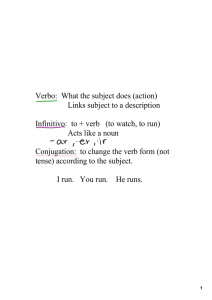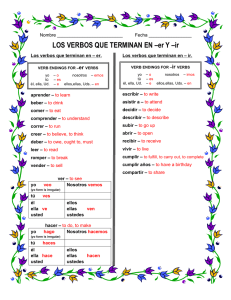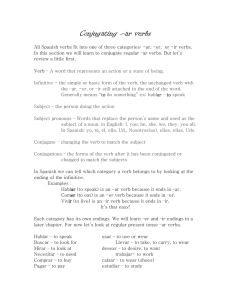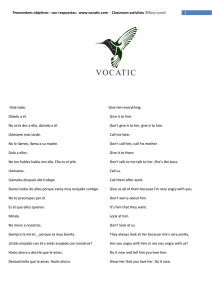Spanish I Chapters 6
Anuncio
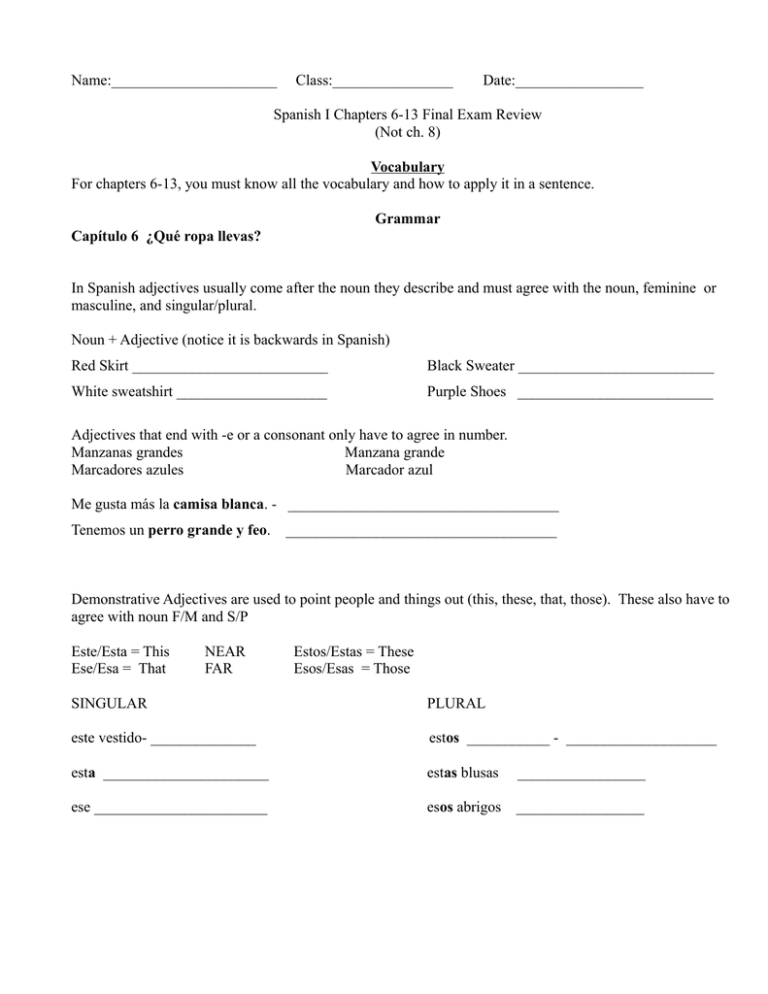
Name:______________________ Class:________________ Date:_________________ Spanish I Chapters 6-13 Final Exam Review (Not ch. 8) Vocabulary For chapters 6-13, you must know all the vocabulary and how to apply it in a sentence. Grammar Capítulo 6 ¿Qué ropa llevas? In Spanish adjectives usually come after the noun they describe and must agree with the noun, feminine or masculine, and singular/plural. Noun + Adjective (notice it is backwards in Spanish) Red Skirt __________________________ Black Sweater __________________________ White sweatshirt ____________________ Purple Shoes __________________________ Adjectives that end with -e or a consonant only have to agree in number. Manzanas grandes Manzana grande Marcadores azules Marcador azul Me gusta más la camisa blanca. - ____________________________________ Tenemos un perro grande y feo. ____________________________________ Demonstrative Adjectives are used to point people and things out (this, these, that, those). These also have to agree with noun F/M and S/P Este/Esta = This Ese/Esa = That NEAR FAR Estos/Estas = These Esos/Esas = Those SINGULAR PLURAL este vestido- ______________ estos ___________ - ____________________ esta ______________________ estas blusas _________________ ese _______________________ esos abrigos _________________ Chapter 7 ¿A Dónde vas a ir de vacaciones? El verbo poder, querer, pensar • Stem-changing verbs in the present-tense Poder Querer Pensar yo puedo quiero pienso tú puedes quieres piensas Él, ella, ud. puede quiere piensa Nosotros podemos* queremos* pensamos* quieren piensan Ellos, ellas, uds. pueden * Nosotros does not have a stem-change. Para + Infinitive • Para means “for” or “in order to” • Whenever is followed by a verb, the verb is in the infinitive form. • Ex: Vamos a Mexico para bucear y tomar el sol. La a personal • When the direct object is a specific person or group of people, we use a before it. ◦ Quiero visitar a mis abuelos. ◦ Quiero visitar al Señor Lopez. • To ask who receives the action of a verb, we use ¿A quién? ◦ ¿A quién quieres visitar? ________________________________________ • Use the personal a also when the D.O. is an animal. ◦ ____________________________________________________ • We usually do not use a after the verb tener. ◦ _____________________________________________________ Chapter 9 Indirect Object Pronoun: me, te, le • • Me duele la mano. My hand hurts. vs. vs. Me duelen las manos. My hands hurt. • Think of it as it hurts vs. they hurt. That is why you use he/she/you f/ it form for one hand and the they form form for hands. • In chapter 9, and 11 we learned all the indirect object pronouns: me, te, le, nos, les In any occasion you use me, this can be replaced with te, le, nos, les if talking about others. Me gusta(n)* I like Te duele(n)* It hurts you Le encanta(n) * Nos interesa(n) * Les fascina(n)* He/she loves It interests us It fascinates them/or you plural *if the verbs end with n then what you are talking about is plural • • I like it vs I like them Me gusta vs. Me gustan Verb Dormir Subject Pronouns Dormir- to sleep Yo Duermo Tú Duermes él/ella/ Ud. Duerme nosotros Dormimos * *no stem-change. ellos/ellas/Uds. Duermen The expressions hace.....que To tell how long something has been going on, we use the expression. Formula: hace + period of time + que + present-tense verb • • Hace dos semanas que tengo fiebre – It has been two weeks since I have a fever. Hace tres días que estoy enfermo – It has been three days since I am sick. La Sustantivación de Adjetivos • We learned to not sound repetitive in Spanish by substituting nouns with words that are usually adjectives. ◦ ¿Te duele la pierna derecha o la izquierda? ◦ La derecha. • Notice how we substituted leg with right. Also, pierna is FS so “La derecha” is all feminine singular. ◦ ¿Prefieres un gorro azul o uno amarillo? ◦ Uno azul. • • Does your right leg hurt or your left? The right. Do you prefer a blue snow hat or a yellow? A blue (one). Notice gorro is MS and so are the colors. Also, notice the use of un gorro and uno amarillo. Use un(a) next to nouns, and use uno(a) when it is not followed by a noun. • We can do the same thing with a prepositional phrase or a description that begins with de. ◦ ¿Qué haces la tarea de español o la de ciencias? - tarea is dropped from the second part. Chapter 10 La Preposición de + el = del • • • In the past we learned the contractions a+el= al (to the) This is due to the back to back vowels We also contract de + el= del (from/of the) Preterite Endings of -ar verbs Comprar to buy Sacar to take out Yo Compré Saqué Tú Compraste Sacaste él/ella/ Ud. nosotros enviar to send envié Compró Compramos ellos/ellas/Uds. Compraron Other verbs that you need to know to conjugate in the preterite: Ir Ver Hacer to go to see to do/make Devolver to return Fui Vi Hice devolví Fuiste viste Hiciste devolviste Fue vio Fuimos vimos Fueron vieron Chapter 11 Comparative Statements Formula: más/menos + adjective + que (than) • Mi gato es más bonito que tu gato. - My cat is prettier than your cat. • Mi perro es menos inteligente que to perro. - My dog is less intelligent than your dog. There are some adjectives we do not use más/menos or more/less in Spanish or in English • Instead of más bueno (more good), we use mejor (que) -better • Instead of más malo, we use peor (que)- worse • • Instead of más viejo, we use mayor (que)- older Instead of más joven, we use menor (que)-younger Just like any other adjective we must agree these with number and gender. Since they end with r then we primarily agree these with number. Mis hermanas mayores. My older sisters. Ellos son mejores que ellas. They are better than them. Superlatives To say someone/something is the most of a group we use this formula: definite article (the) +noun + más + adjective • Para mí, The Office es el programa más divertido. - For me, The Office is the most amusing show. To say something is the best or worst, definite article -the- is very important. The = El, La, Los, Las el/la mejor comes before the noun • Pienso que Meryl Streep es la mejor/peor actriz. - I think that Meryl Streep is the best/worst actress. When indicating the category, do so with de before the group or category • Meryl Streep es la mejor actriz de las películas.- Meryl Streep is the best actress of/in the movies. Direct Objects • • Direct Objects (Lo,La,Los,Las) can be attached to the infinitive or come before the conjugated tense verb. Steps: 1. identify the noun 2. ask: gender & num,ber 3. identify the verb 4. ask: conjugated or infinitive 5. Conjugated- BEFORE the verb; Infinitive- ATTACHED • • Lo voy a ver. Voy a verlo. – Both these sentences mean the same thing. I am going to see it. Indirect Object Pronouns: me, te ,le , nos, les • List of verbs that use the indirect object pronouns: dar (to give), doler (to hurt), encantar (to love something), fascinar (to fascinate), gustar (to like), interesar (to interest) • Steps for I.O. Pronouns: 1. 2. 3. 4. Identify the subject Conjugate the verb Determine to/for who Place the corresponding I.O. Pronoun in front of the conjugated verb. Chapter 12 Verbos con el cambio de e-i Pedir to ask/to order servir to serve yo pido sirvo tú pides sirves él/ella/ud pide sirve nosotros pedimos* servimos* ellos, ellas, uds piden sirven * the nosotros form does not have a stem change • The infinitives of all e-i verbs end in -ir. Notice that the endings follow the pattern of regular -ir verbs. Also know these verbs stem changes: • poder (o-ue) puedo • pensar (e-ie) pienso Verbo Traer Traer to bring yo traigo tú traes él/ella/ud trae nosotros traemos ellos, ellas, uds traen Indirect Object Pronouns • me, te, le, nos, les • Place them in front of the conjugated verb. Les voy a traer guacamole. -OR• Attach it to the end of an infinitive verb. Voy a traerles guacamole. • To clarify meaning, use a + pronoun Rafael le trae el postre a ella. * Red flag: Do not be misled my these indirect object pronouns. They do not indicate the conjugation of the verb. They tell "to/for" that person. List of verbs that use the indirect object pronouns: pedir, gustar, interesar, faltar, fascinar, traer, servir, (doler) Preterite of -er/-ir verbs • Endings: -í, iste, ió, imos, ieron Comer to eat Salir to leave/exit yo comí salí tú comiste saliste él/ella/ud comió salió nosotros comimos salimos ellos, ellas, uds comieron Salieron Chapter 13 Present Conjugation of the Verbs: Decir & Saber Decir- to say/ to tell *Saber- to know yo digo sé tú dices sabes él/ella/ud dice sabe nosotros decimos sabemos ellos, ellas, uds dicen saben • When saber is immediately followed by the infinitive, it means - “to know how to” ◦ Example: Mis amigos saben esquiar muy bien.// My friends know how to ski very well. El Mandato Affirmativo (Affirmative Command) • • • It tells someone to do something. How to form an affirmative command: Conjugate the verb in the el/ella/ud. Form in the present, but still refer to the person as tú. ◦ Example: Pablo, apaga las luces por favor.// Pablo, turn off the lights please. Irregular commands: ◦ poner (to put/set/place) – pon ◦ hacer – (to do/make) – haz ◦ decir – (to say/ tell) – di • • When you add an D.O. Pronoun (lo, la, los, las), it is attached to the command. Follow the steps: ◦ 1. Identify the noun ◦ 2. Ask: gender & number ◦ 3. Determine what D.O. Pronoun you will use. • • Example: ¿Qué debo hacer con las botellas? - Separalas, por favor. Remember, when you have 2 nouns of different genders, you will use los (M. P.)
